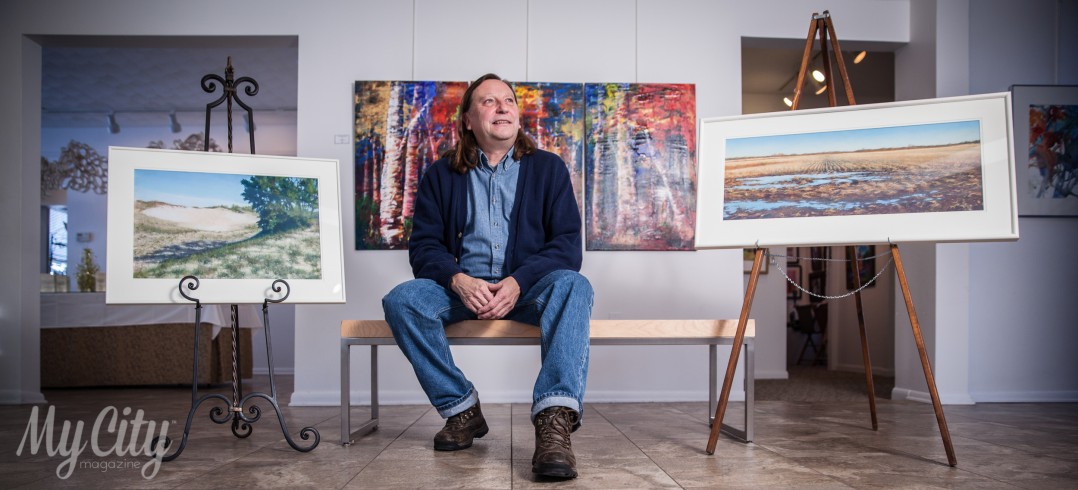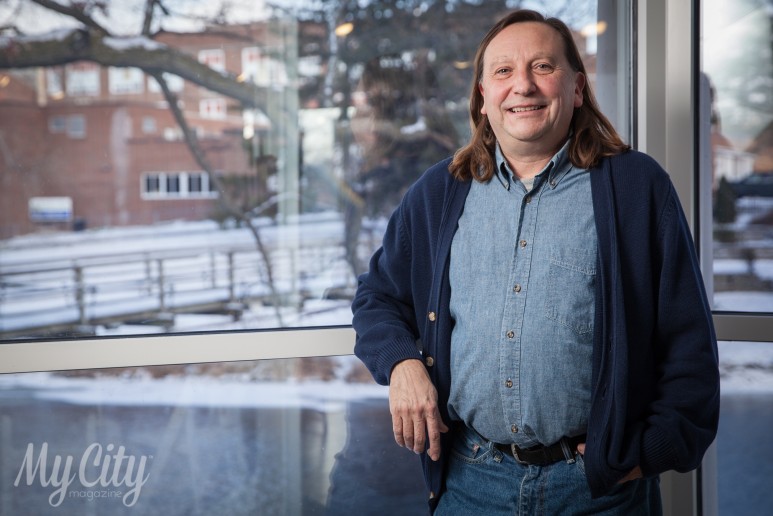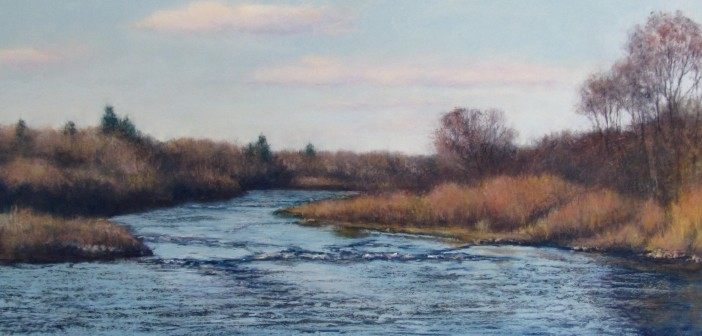
Ifyou’ve ever driven in Michigan, you know that sometimes it’s difficult to keep your eyes on the road because of the incredible natural beauty that surrounds us. Instead of passing by these fleeting scenes, Thomas Tomasek stops and captures the splendor in one of his pastel paintings.
Growing up on a farm near Chapin, MI – if you’ve never heard of it, that’s okay, because it’s not even big enough to be a town – Tom has always loved the landscapes of the Mitten. “I attribute my love of landscapes to my rural upbringing,” he said. “My appreciation includes not only the beautiful places like the Great Lakes, but also the ordinary views, like the farm fields we drive by every day. I feel it is all an important part of our state and hope others see the beauty in the mundane as well as in the spectacular.” Tom’s paintings are, in part, an effort to get people to see the beauty in everyday views of the Michigan landscape. The artist is also aware that his paintings preserve a landscape that is changing. “A lot of farmland is being gobbled up and the scenes that I paint are disappearing,” he said. “It breaks my heart.”
“I think that in these hectic times, a brief escape into a peaceful landscape provides a reminder of what is really important in life.”
Thomas Tomasek
Tom says he started drawing at an early age and has worked in a variety of mediums over the years. As he began exhibiting in the early 90s, he encountered the work of pastel artist Jerry Power. “I was always impressed with his landscapes,” Tom remembered, “It was not just the way he handled the material, but also the scenes he chose to paint. They were the same type of landscapes I was drawn to.” Tom attended a workshop to learn Jerry’s process and says he has seen big leaps in his own art ever since. “This process utilizes a paper with a sanded surface, allowing the artist to apply many layers of color,” he explained. “Unlike paints, which contain other materials, quality pastels are nearly all pigment, which results in rich color. ” Tom says that if you look very closely at one of his pieces, you can see a lot of crazy colors, but when you step back, the effect is an accurate portrayal of the landscape in whole. But it’s not just the scenery that enthralls him. “I am trying to capture not just a view, but also a feeling that a place evokes. When I finish a painting, my hope is that it enables me to return to that place and moment. I’m especially happy when others who view my work can also feel a sense of that place and time.” Tom captures the living spirit of the land so well that Michigan residents gazing at his paintings may almost feel that they are looking at their own memories of this state.
 While many of his larger pieces are produced at his studio, Tom also paints en plein air, i.e. on location outdoors. Tom says he enjoys both for different reasons. “The weather and the light change so fast outdoors that I tend to do smaller works there,” he explained. “There are times I will do a small study to get a color reference and a feel for a place and at the same time I will take photos so I am able to produce a larger work in the studio using both as a reference.” When teaching his workshops, Tom highly recommends artists work out of doors. “I always tell participants that even if they don’t aspire to be an outdoor painter, to do it anyway. It really helps back at the studio because it teaches you to eliminate unnecessary details.”
While many of his larger pieces are produced at his studio, Tom also paints en plein air, i.e. on location outdoors. Tom says he enjoys both for different reasons. “The weather and the light change so fast outdoors that I tend to do smaller works there,” he explained. “There are times I will do a small study to get a color reference and a feel for a place and at the same time I will take photos so I am able to produce a larger work in the studio using both as a reference.” When teaching his workshops, Tom highly recommends artists work out of doors. “I always tell participants that even if they don’t aspire to be an outdoor painter, to do it anyway. It really helps back at the studio because it teaches you to eliminate unnecessary details.”
Tom’s art has gotten him state, national and even international attention. In 2010-11, three of his paintings were selected for exhibition at the Michigan Governor’s residence. In 2013, Tom was one of 100 artists chosen from 3,000 applicants to be featured in Pastel Journal magazine, “the Bible of all pastel painters,” Tom said with a chuckle. That same year, he submitted a piece which was chosen for a book called Art of the Sleeping Bear Dunes. In addition to teaching, Tom just returned from a fall 2014 trip to Japan. He was chosen to participate with three other artists in a Japanese-U.S. art exchange program which included workshops and exhibitions at Japan’s own “Great Lake”: Lake Biwa. “I try to put myself out there and try to do new things,” the artist said modestly, “but really, I feel fortunate to be part of the art community.”
When he’s not painting the outdoors, Tom is still enjoying the rural areas of Michigan, hiking in the summer and cross-country skiing in the winter. As for the real reason behind his art, Tom said, “I paint for myself really, but it’s very gratifying when other people like what I do.” ♦
Photography by Mike Naddeo














